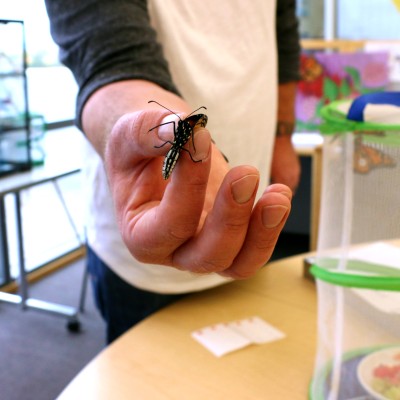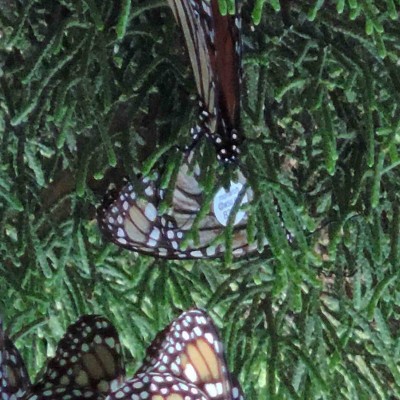Her scientific name is B-3930. But as of today, she may as well be called “Miracle.” A Monarch butterfly—raised at College of Western Idaho (CWI) from a caterpillar—is making history in the Pacific Northwest scientific community. Not only is she the first Monarch tagged from Idaho to show up in an overwintering colony since the program started in 2012, she holds the record for being the latest tagged and released butterfly to be spotted 537 miles away in California.
“This butterfly’s recovery is significant not only locally, but regionally,” Assistant Professor Dusty Perkins, who leads CWI’s Monarch butterfly conservation efforts, said. “Not only is she the first Idaho butterfly from recent tagging efforts to be spotted after migration, she also holds the record for the latest departure of an individual from our latitude that has successfully migrated.”
Miracle was released at Deer Flat National Wildlife Refuge in Nampa on Oct. 29. It happened during a public event on a very cold, windy day. At the time, many doubted she would make it very far if she even made it at all. Vance McFarland, the CWI Biology program student who raised her and served as the project’s student lead, knew recovery was slim, but held on to strands of hope saying it was well worth trying.
“I was there, and I’m the one who let her go,” McFarland, who has worked closely with the project for the past two years, said. “I kept her at my house for a few days hoping the weather conditions would improve, but it didn’t look like that was going to happen anytime soon. I figured this is what it’s like in nature, so I just let her go.”
Miracle was released with another butterfly; B-3931. This past fall, Perkins and fellow instructor Hollie Leavitt engaged more than 50 CWI students and community volunteers in tagging efforts, milkweed and Monarch mapping, and seed collection efforts. These were the last two butterflies raised, tagged, and released through CWI.
“When I let her go, she took off right away,” McFarland said. “B-3931 hung out for a while, but (Miracle) seemed antsy to leave. Now I see why. I’m beyond happy she made it.”
Thirty-two days later, Miracle was spotted in a tree at Lighthouse Field in Santa Cruz by John Dayton; a butterfly enthusiast in California. He snapped a few pictures of her that helped Monarch watchers identify her as one of CWI’s butterflies through her wing tag.
“Our project would not be possible without a lot of regional collaboration and support,” Perkins said. “Deer Flat National Wildlife Refuge has allowed us the opportunity to conduct extensive field research over the past two years, and Dr. David James at Washington State University provided the tracking tags that allowed us to be part of this larger western Monarch migration study.”
Miracle will spend the winter in California. By early spring, she will hopefully mate and lay her eggs on several milkweed plants. From there, the eggs will hatch, develop into caterpillars, and transform into adult butterflies that will complete the journey back to Idaho. By the time that happens, McFarland will have completed his education at CWI. He says the experience has changed his life. The combat veteran, who once trained bomb-sniffing dogs as an infantryman in the U.S. Army, is now hooked on butterflies. He plans to continue his Monarch research when he transfers to Boise State University.
The Monarch Butterfly Conservation Project was one of three grant-funded projects at CWI through the National Science Foundation and the Idaho EPSCoR program.




